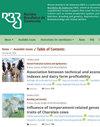Efficiency of chemical preservatives used in raw milk samples for bacterial counts by flow cytometry
IF 1.2
4区 农林科学
Q3 Agricultural and Biological Sciences
Revista Brasileira De Zootecnia-Brazilian Journal of Animal Science
Pub Date : 2023-04-03
DOI:10.37496/rbz5220220058
引用次数: 0
Abstract
- The objective of this study was to evaluate and compare two chemical preservatives in terms of their sample preservation capabilities, considering the individual bacterial count (IBC) and time and temperature variables. Samples were collected in expansion tanks in three commercial dairy farms located in the northwest of Rio Grande do Sul, characterized as G1: low IBC values, G2: average IBC values, and G3: high IBC values. The tanks were stored at three different temperatures (4, 10, and 25 °C) for 14 d. Samples supplemented with the preservative Azilat in G1 (lower IBC group) exhibited the best results at a temperature of 4 °C, whereas for G2 and G3, the results showed no statistically significant difference between temperatures 4 and 10 °C. The temperature 25 °C exhibited the worst results. For samples preserved with Azidiol, regardless of the studied group (G1, G2, and G3), the temperatures of 4 and 10 °C did not present a significant difference regarding the preservation of the samples, with the temperature of 25 °C exhibiting the worst results. Azilat was effective in keeping the samples conserved when they presented low IBC, being able to fluctuate with the increase in IBC and temperature variation. Azidiol was effective regardless of the initial IBC level.用流式细胞术对原乳样品进行细菌计数的化学防腐剂的效率
本文章由计算机程序翻译,如有差异,请以英文原文为准。
求助全文
约1分钟内获得全文
求助全文
来源期刊
CiteScore
1.90
自引率
0.00%
发文量
25
审稿时长
8 weeks
期刊介绍:
The Revista Brasileira de Zootecnia (RBZ; Brazilian Journal of Animal Science) encompasses all fields of Animal Science Research. The RBZ publishes original scientific articles in the areas of Aquaculture, Biometeorology and Animal Welfare, Forage Crops and Grasslands, Animal and Forage Plants Breeding and Genetics, Animal Reproduction, Ruminant and Non-Ruminant Nutrition, and Animal Production Systems and Agribusiness.

 求助内容:
求助内容: 应助结果提醒方式:
应助结果提醒方式:


